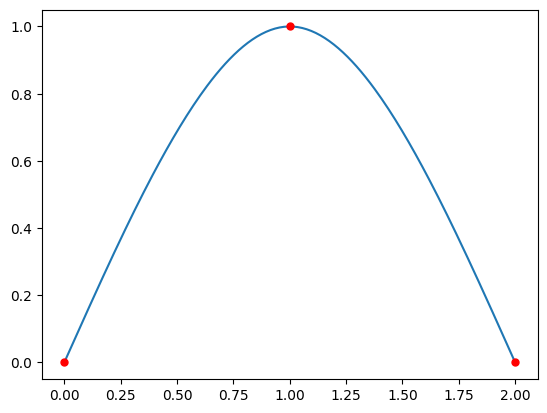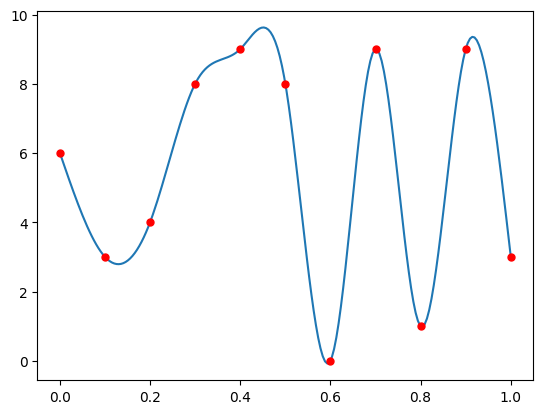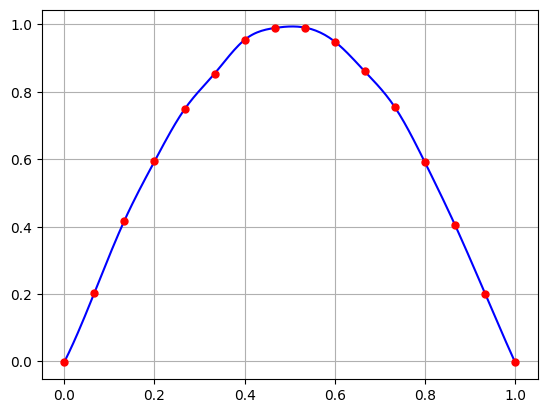Natural Cubic Spline Interpolation#
import numpy as np
import scipy.linalg as la
import matplotlib.pyplot as plt
from scipy.interpolate import CubicSpline
Given \(N+1\) data points \((t_0,y_0), \dots , (t_N,y_N)\) we want to construct the natural cubic spline: a piecewise cubic polynomial function \(p(t)\) such that:
\(p(t)\) is defined by \(N\) cubic polynomials \(p_1(t),p_2(t),\dots,p_N(t)\)
Each \(p_k(t)\) is defined on the subinterval \([t_{k-1},t_k]\)
\(p(t)\) is continuous
\(p(t)\) is smooth (ie. \(p'(t)\) and \(p''(t)\) are continuous)
\(p(t_k)=y_k\) for all \(k=0,\dots,N\)
Example 1#
Consider \((0,0),(1,1),(2,0)\). Construct the linear system for the cubic spline.
A = np.array([[1,1,1,0,0,0],
[3,2,1,0,0,-1],
[6,2,0,0,-2,0],
[0,0,0,1,1,1],
[0,2,0,0,0,0],
[0,0,0,6,2,0]])
A
array([[ 1, 1, 1, 0, 0, 0],
[ 3, 2, 1, 0, 0, -1],
[ 6, 2, 0, 0, -2, 0],
[ 0, 0, 0, 1, 1, 1],
[ 0, 2, 0, 0, 0, 0],
[ 0, 0, 0, 6, 2, 0]])
y = np.array([1,0,0,-1,0,0]).reshape(6,1)
y
array([[ 1],
[ 0],
[ 0],
[-1],
[ 0],
[ 0]])
c = la.solve(A,y)
c
array([[-0.5],
[ 0. ],
[ 1.5],
[ 0.5],
[-1.5],
[ 0. ]])
np.linalg.cond(A)
14.530258040767446
Now let’s use scipy.interpolate.CubicSpline to compute the natural cubic spline and compare our results.
t1 = [0,1,2]
y1 = [0,1,0]
cs1 = CubicSpline(t1,y1,bc_type='natural')
T1 = np.linspace(0,2,200)
Y1 = cs1(T1)
plt.plot(T1,Y1,t1,y1,'r.',markersize=10)
plt.show()

Verify the coefficient matrix:
cs1.c
array([[-0.5, 0.5],
[ 0. , -1.5],
[ 1.5, 0. ],
[ 0. , 1. ]])
Example 2#
N = 10
t2 = np.linspace(0,1,N+1)
y2 = np.random.randint(0,10,N+1)
cs2 = CubicSpline(t2,y2,bc_type='natural')
T2 = np.linspace(0,1,200)
Y2 = cs2(T2)
plt.plot(T2,Y2,t2,y2,'r.',markersize=10)
plt.show()

Example 3#
Let’s interpolate the points \(\sin(\pi t_k)\) for \(t_k = k/N\) for \(N=15\) with added noise.
N = 15
t3 = np.linspace(0,1,N+1)
noise = 0.005*np.random.randn(t3.size)
y3 = np.sin(np.pi*t3) + noise
cs3 = CubicSpline(t3,y3)
T3 = np.linspace(0,1,200)
Y3 = cs3(T3)
plt.plot(T3,Y3,'b-',t3,y3,'r.',markersize=10)
plt.grid(True)
plt.show()

The cubic spline is not sensitive to small changes in the \(y\) values.

